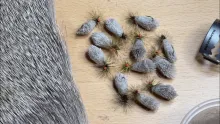This is the Mundane Fly Manifesto: Few and cheap materials, easy to find in the shops. Simple tying methods. Mundane flies. The whole idea is to make it simple and efficient to tie flies that work.
|
|
|
|
|
|
|
|
I have always thought that complex flies were a menace. On one side I can be fascinated by a meticulously thought out imitation with many materials and intricate tying steps, and I sometimes enjoy tying such flies for fun. But on the other hand I hate tying them when I just need to fill my boxes.
Intricate flies don't last longer than the simple ones. On the contrary. Many of the complex constructions are fragile. And teeth will shred complex flies as well as simple ones, rocks will smash them, rust will eat them.
Some people think that intricate flies and precise imitations catch better than simple ones, but my personal experience is that really meticulous imitations aren't necessary to get fish to bite. Fish are generally stupid and gladly go for something that has the right key factors. I'm definitely for suggestive rather than imitative.
I honestly think fish care very little for very precise imitations - even the selective fish.
I'm definitely for suggestive rather than imitative.
I love simple patterns with few tying steps and even fewer materials.
The CDC&Elk, the Woolly Bugger, the Copper Bully, the Fluff, the Hare's Ear Bugger, the Clouser.
Three materials or fewer and nothing complicated.
It started with untested fantasy flies
Following this principle I decided a couple of years ago that I would toy with some ideas for flies that I know I would need for the coming season. Even though I had most of them covered with the patterns I already tie, use and love, I thought it would be a fun exercise to develop something new.
I was toying with the idea of using a limited selection of commonly available materials. I started dotting down some principles, and wound up with the rules sketched below. These flies are kind of dogma flies - tied under strict rules and severe limitations. I decided these rules before I thought out the flies.
The patterns that came from these rules are mainly sea trout flies for my own home water fishing. No nymphs, no dries, no hoppers or beetles. The flies will work for many other kinds of fish, but I made these primarily to satisfy myself and my own needs.
You also need to realize that most of these flies were created while there was still ice on my home waters, and that some of them haven't been truly tested in their final form. These are in other words a classical example of a type of flies, for which I usually have no respect: unproven fantasy flies, which haven't seen any action and proved their worth in the real world.
But of course these are different!
These flies are mine, and I'm sure they will work!
...a type of flies, for which I usually have no respect: unproven fantasy flies
First of all they are based on proven concepts. All have traits to imitate large groups of common prey like shrimp, worms and different types of small fish.
And finally - not that I really want to admit it - but our trout and most other fish are pretty stupid and not really picky about what they eat. Sea trout as well as many other species are opportunists. Fish like large- or smallmouth bass, stripers, numerous cod species and even tropical saltwater fish such as tarpon and GT's will also like these flies, I'm sure.
So with this guarantee that they will catch fish, let's go to the rules.
The rules
Hooks? Not hooks, but hook. Singular.
All are to be tied on the same hook. Not only the same make and model, but the same size!
I love the Kamasan B170 and the B175 hooks, but I find that the weight of the slightly thicker B175 helps my flies sink, which I like.
So Kamasan B175 it is.
Other hooks can do, but this is what I choose. And not too big, but not too small either, so I go for a size 6 or 4. These are perfect sizes for most of my fishing. The hook is a good looking normal shank length, down eye, Limerick bend hook, which endures saltwater just fine.
So what else?
Tying thread? Black 8/0! Just that.
Materials? Well, no more than three in a fly, excluding thread and hook, but including cones, eyes, extra weight and whatnot. And it has to be commonly available materials, which can be easily found or easily substituted. The materials can be used more than one place, though, so three materials doesn't equal three elements to the fly, and some materials offer more than one texture or structure. A rabbit skin has both cover hair for wings and dubbing, and a hackle feather has fibers for tails, a hackle as well as some fluffy stuff for other purposes.
Tying methods? They have to be simple and easy, keeping all flies on a beginner's level. No special tools will be required. No stackers, no razor blades, no dubbing twisters.
I very much want a to sneak a muddler into the bunch. But at the same time I don't want to repeat existing patterns too much, so I don't want any Woolly Bugger types or traditional hackle flies.
I know I'm not going to revolutionize anything, but I'll try to stay away from the very traditional.
I need some flies in my own boxes, which make it difficult to stray to far from the obvious: sand eels, shrimps, scuds. It's difficult to invent something new there, but we'll see.
And the flies will not be finished with epoxy, special glues or exotic rubber mixtures. Just plain varnish or maybe a dap of super glue. Something that's easy and already in everybody's tying boxes.
So the mundane dogma rules are:
1) Kamasan B175 size 6 (or any similar common hook of your choice)
2) Black 8/0 thread (or what black thread you have on your tying table)
3) Three common materials at the most
4) Varnish or super glue
5) Easy to tie with no special tools or difficult tying methods
You can stray from this narrow path of chastity and use other hooks, other colors thread or even more or hard-to-get materials, but that will break the vow of this Mundane Manifesto, which really urges you to keep things simple and become creative through simplification.
This Mundane Manifesto urges you to keep things simple and become creative through simplification.
Hand picked for this article
- Log in to post comments


















Jon,
Congratulati
Jon,
Congratulations with the fly and the fish! It sounds like you hit the spot with your simple tube fly. Excellent!
Martin
Hi Martin,
Please e
Hi Martin,
Please excuse me, I couldn't contact you via e-mail as I don't have a Microsoft account etc...
However, with reference to you keeping it simple. I tried to do the same with Tubes. Using, simply the cut off tubes from ear cleaning ear-buds. Then simply whipping on a collection of the same colour strands of tinsel, slightly longer than the Tube , to cover the hook etc..I went fishing last week and thought I would use them on one of the most horrific days of the week, weather wise. I caught some magnificent Browns and a bag full of Rainbows. I was absolutely gob-smacked about the results. It didn't matter whether I retrieved the Tube-fly fast or slowly. I still got fish. The tubes in question , were only 2 to 2&1/2 inches long. I tied the tinsel strips on with white cotton and actually used a permanent ink pen to dot on a black eye dot onto the white cotton etc...How much more simple could they be ? With fish in the bag ?
Tight lines
Jon
Bob,
I'm really,
Bob,
I'm really, really sorry about going simple! I know that these flies will be simpler than just a single antenna in one of your fly sculptures, but I hope you forgive me!
Martin
Neil,
It's not di
Neil,
It's not difficult. I did a quick writeup of the process of submitting one or more patterns, and any further questions can be directed to me as a comment or via mail as mentioned in the article.
Martin
Hey martin quick que
Hey martin quick question. if were going to submit emails, what needs to be included? tying steps, materials and the finished product?
Thanks.
Martin,
OH-OH t
Martin,
OH-OH there you go thinking again, this time on how to make us who over-complicate things by throwing a rock into our untidy brains and forcing us to think of simplicity.